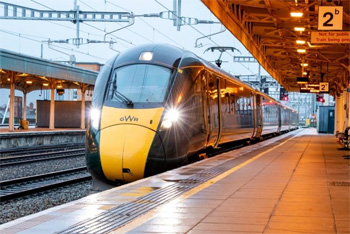Wales now has electrified rail track for the first time in 60 years but the amount of diesel used for both passenger and freight trains on Britain’s rail network increased in the last year.
Regulator the Office of Rail and Road (ORR) has published statistics on rail emissions and Rail Infrastructure and Assets 2019-20, which states that 6,049 km (38%) of the mainline railway route (15,904 km) is now electrified .

A GWR bi-mode train on the London-Cardiff route
In 2019-20, 251km of new electrified track was added to the network. This was related to the Lee Valley Rail Programme, and Great Western Electrification plan.
Under the Great Western programme, work to electrify the line between London Paddington and Cardiff Central was completed in January.
The ORR said this meant Wales had electrified track for the first time during the year, although an earlier electrified railway operated until 1959.
Four new mainline stations opened in 2019-20: Meridian Water; Robroyston; Warrington West; and Worcestershire Parkway.
Three stations closed. Two closures were related to factory closures while a third closure, Angel Road which permanently closed in May 2019, was due to the a new Meridian Water station opening nearby.
The net effect was to bring the total number of stations to 2,567.
Paul Tuohy, chief executive of Campaign for Better Transport, said: 'It's great to see rail lines being electrified and new stations opened, but now we need to step up our game. Only 38% of the railway is electrified: we need a rolling programme of electrification to meet the Government's net zero targets. And too many communities are unable to access the rail network: new or reopened rail lines and stations could transform these places.
'Now more than ever, we need investment in rail infrastructure - not just to enable more sustainable travel, but to create jobs, tackle social exclusion and help the economy to recover.'
Electricity usage by passenger trains increased by 5.3% and diesel usage increased by 1.5% compared to 2018-19. Over the same time period, passenger kilometres decreased by 1.3%.
The resulting CO2 emissions for passenger trains fell to 35.1g CO2 per passenger km. The ORR said this was the lowest level since the comparable statistical series started in 2011-12 and was predominantly due to a transition towards renewable energy sources in the electricity sector in Great Britain.
The amount of diesel consumed by freight trains in 2019-20 also increased – by 12.5% to 172 million litres. Officials said this is the highest figure since 2015-16, and the first time that diesel use increased year on year since 2015-16.
Electricity usage fell by 6.3% to 70 million kWh.
As a result, CO2 emissions for freight trains increased to 27.5g CO2 per tonne km. This is the highest level since the comparable time series started in 2011-12.
The average age of rolling stock for all train operators is 17.3 years, down by 1.9 years since 2018-19. Officials said this was due to several operators introducing new stock.
Register now for full access
Register just once to get unrestricted, real-time coverage of the issues and challenges facing UK transport and highways engineers.
Full website content includes the latest news, exclusive commentary from leading industry figures and detailed topical analysis of the highways, transportation, environment and place-shaping sectors.
Use the link below to register your details for full, free access.
Already a registered? Login